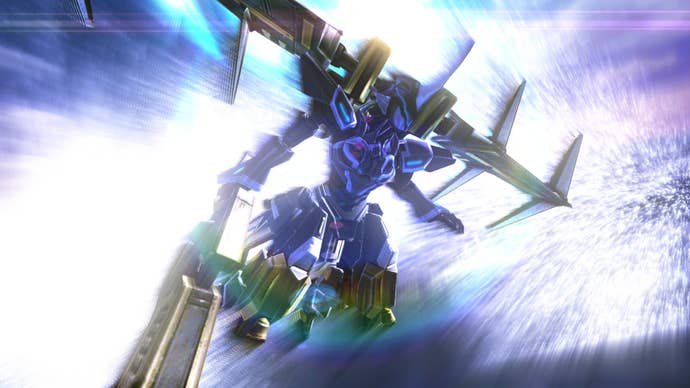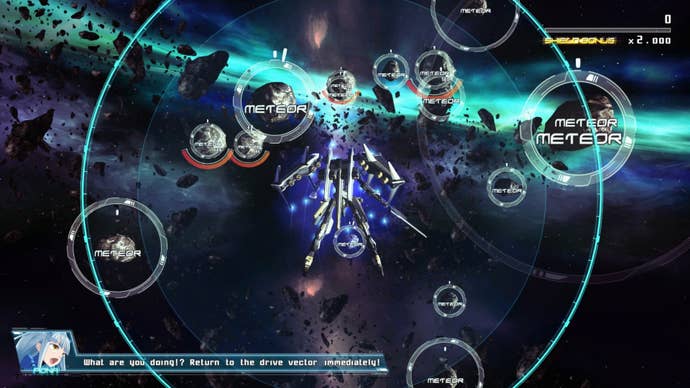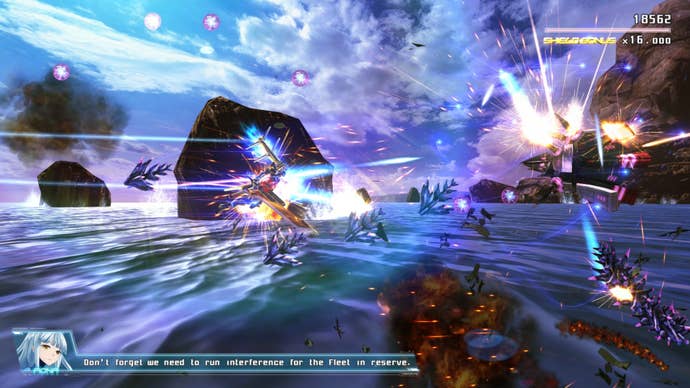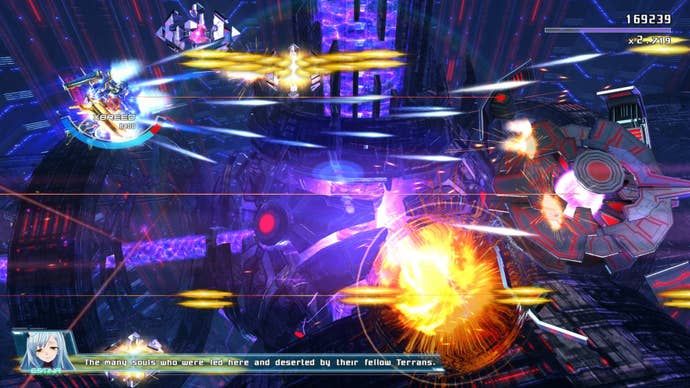Astebreed PC Review: Stunning Shmup Action
Edelweiss' latest title for PC is an impressively cinematic shoot 'em up that offers a considerable amount of depth beneath the eye candy.
This article first appeared on USgamer, a partner publication of VG247. Some content, such as this article, has been migrated to VG247 for posterity after USgamer's closure - but it has not been edited or further vetted by the VG247 team.
There's an assumption among certain quarters of the gaming community at large that small-scale, independently developed games can never quite match the sheer audio-visual spectacle that triple-A offers.
To those people -- and to anyone else who likes a cracking good time -- I present to you Edelweiss' Astebreed, the most spectacular, beautiful shoot 'em up I've seen for a good long while.
Edelweiss, for the unfamiliar, is a Japanese doujin (independent) developer that, prior to Astebreed, has brought two PC games -- Fairy Bloom Freesia and Ether Vapor Remaster -- to the West via localizers and distributors. Both of these titles are extremely technically proficient, happily running at a blistering 60+ frames per second at full 1920x1080 HD resolution even on a modest rig. Each of them is also a really solid game in its own right -- Ether Vapor Remaster is a scrolling shmup that uses its 3D graphics to shift between perspectives during gameplay, while Fairy Bloom Freesia is an enjoyable platform brawler starring an adorable little fairy girl with a penchant for punching everything in the face.

And so we come to the company's most recent Western release, Astebreed. Taking its cues from Ether Vapor Remaster, Astebreed is once again a shmup that features dynamic, sweeping camera angles that pan, swoop and zoom around during gameplay, effortlessly shifting the action from top-down to side-on to into-the-screen 3D and back again without missing a beat. While visually spectacular to watch, even if you're not playing, the times when the perspective changes and the camera swishes around are consistently and sensibly timed to coincide with brief -- often much-needed -- moments of downtime in the action. In other words, the sheer visual spectacle of the game doesn't come at the expense of gameplay or the ability to see what is going on; instead, it makes the whole thing into a distinctly cinematic experience, a feeling further compounded by the enjoyable, interesting and dramatic but unobtrusive plot that is threaded through the course of the game's six stages.
Taking on the role of a mecha pilot named Roy, the narrative tells a creative sci-fi tale about an mysterious, threatening alien force known as the Filune. Accompanied by Fiona, a young girl forever modified by human experimentation to effectively become part of the Xbreed mecha's weaponry system, Roy must battle his way through swarms of enemies to discover the truth behind the disappearance of Fiona's sister -- and the invasion of the Filune. The whole story is short -- you'll probably complete it in about an hour and a half on your first runthrough if your skill level is anything like mine (i.e. not terribly high) -- but it's well-paced, packing as much drama into its six chapters as more sprawling games do across 30 or 40 hours.
The story is enjoyable, interesting, well-told and well-acted by the Japanese voice actors, but there's one minor niggle with it: there's a lot of dialogue that unfolds in the thick of the action, and unless you speak Japanese fluently enough to be able to understand it without reading subtitles, you're almost definitely going to miss some of it amid all the chaos. The subtitles are relegated to the bottom-left corner of the screen, which ensures they don't get in the way of the action, but also makes it difficult to give any attention to them while you're fighting. It's a minor issue -- and once you start playing for high scores rather than the story, you can turn all the dialogue off anyway -- but it did detract very slightly from the otherwise immaculately presented drama of the tale the game tells.

Gameplay-wise, Astebreed is an interesting beast. The Xbreed is armed with two different types of long-range "shot" attacks -- one fires in a spread pattern, while the other focuses the same amount of bullets into a more concentrated, focused area -- and a sword for melee attacks. Both types of shot can be "locked on" by holding the respective button down -- locking on the spread shots allows you to target enemies anywhere in a circular area around you, while locking on the focused shot allows you to target anything within a fairly narrow cone in the direction you press -- and different types of attacks can be used to nullify certain types of bullets. You also have a special "EX Attack" when you've built up enough energy, and this in turn has three different means of execution, each of which has its own unique benefits.
It initially appears to be quite complicated, but an interactive prologue gives you the opportunity to play with the controls in a relatively "safe" context, and a full, optional tutorial explains all the concepts in detail if you want to know a little more. Of chief importance to those playing the game for bragging rights rather than the story is the scoring system, and in true Japanese shmup style it's an intricate affair that rewards not only familiarity with the game mechanics, but also borderline superhuman skill.

Here's how it works: so long as the Xbreed has shields, you can build up a score multiplier by destroying enemies using the shot-type attacks. This multiplier can then be taken advantage of by destroying enemies using the sword attack -- which is a more powerful attack capable of repelling a lot of different enemy projectiles anyway. The twist to prevent you from just spamming the sword combo is that every time you hit an enemy using the sword, the multiplier drops back down again, so you'll need to balance both your shot and melee attacks to obtain the highest scores. Oh, and avoid the chaos of incoming bullets, too; taking any shield damage drops the multiplier right back down to 1.
Astebreed certainly isn't a danmaku ("bullet hell") shooter, but in order to succeed it does require many of the same skills and character traits. Most notably, it's a game that rewards the ability to stay calm amid utter mayhem unfolding on screen -- working out the best position to sit to avoid damage, working out the best means of efficiently destroying enemies, and determining when it's safe to go wild with the sword and take advantage of that multiplier you've been building up. This becomes particularly apparent during the boss battles which, in true old-school tradition, make use of learnable patterns across several phases. The boss fights become increasingly complex as the game progresses, with the final two battles in particular being extremely demanding but enormously satisfying affairs that reward careful, methodical play rather than simply going in all guns blazing -- or, indeed, sword a-swingin'.
The beauty of Astebreed as a complete package is that there's really something here to cater to most tastes. Narrative junkies can enjoy a full, satisfying, enjoyable and well-told story in the space of 60-90 minutes. Score attack fans can take advantage of the game's detailed stat-tracking at the end of each level -- including a great graph that shows how your multiplier rose and fell over the course of the chapter. Mecha enthusiasts should beat the game at least once in order to take advantage of what I've come to regard as the "giant robot pornography" feature, which allows you to get up close and personal with all the 3D mechanical models in the game and even fiddle around with their flaps and flamey bits to your heart's content. Fans of Japanese animation and art can indulge in the beautiful artwork that punctuates the story sequences -- and which, after beating the game once, is viewable from the main menu. And anyone who just wants a game with which to impress their friends, well, Astebreed certainly fits the bill there, too.

All in all, it's a great package for a great price, with the only real minor flaws being the aforementioned difficulty in reading the subtitles while attempting to fend off the incoming enemy hordes -- and perhaps, for some, the relatively small number of levels, though this is nothing unusual for the shmup genre. Aside from these considerations, Astebreed is a game that, in terms of quality and design, puts many recent triple-A releases to shame and which, for those who have yet to discover the joys of Edelweiss' work, is a fine place to get acquainted with this talented Japanese developer.
And for those of you who are already familiar with Edelweiss' work? Well, you probably already bought it anyway, didn't you?
VisualsA rock-solid frame-rate coupled with beautiful, colorful visuals, excellent art design and some wonderfully cinematic camerawork makes for a gorgeous-looking game.
SoundGood quality Japanese-language voice acting helps tell the story, while an energetic, pumping -- if, arguably, slightly unmemorable -- soundtrack complements the action well.
InterfaceAlthough there's a lot going on on screen at once, information is presented to the player simply and clearly, and the game does a good job of teaching its special mechanics.
Lasting AppealThe story may be short, but a ton of replay value comes from the extremely solid, detailed systems designed to help score attack players up their game.
ConclusionStunning to look at, slick and fluid to play as well as being a satisfying -- but never insurmountable -- challenge, Astebreed is a top-quality game that everyone with even a passing interest in shoot 'em ups should have in their collection.
